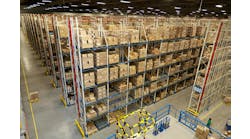Improvements to the U.S. economy have resulted in increased warehouse activity (through boosted demand) and a decrease in unemployment numbers. As a result, warehouses are battling a serious labor shortage as hiring needs surge. Across the board, organizations are struggling to attract talent for warehouse positions, and job applicant numbers have dipped significantly. The Labor Department reported that the warehouse and storage sector added over 52,000 jobs over the last 12 months, but according to ARC Advisory Group, 50% of open warehouse positions today receive fewer than five applicants.
The increased number of warehouse positions is due in large part to the explosive growth of direct-to-consumer (DTC) sales, with 81% of consumers planning to purchase from a DTC brand over the next five years, according to the Diffusion 2018 Direct-to-Consumer Purchase Intent Index. This growing sector of retail, with its faster delivery times and constantly growing number of small e-commerce orders, is putting new demands on warehouses that were originally designed to fulfill fewer, larger wholesale and/or retail store replenishment orders. Thus, the incorporation of machines and automation that can assist and augment human workers has become critical in distribution facilities. As Henry Ford once said, “For most purposes, a man with a machine is better than a man without a machine.”
Let’s take a look at how “man + machine” partnerships are already making an impact with new technologies in the warehouse and what this collaboration means for the future.
Warehouse Management Designed for Modern Technology
Traditionally, two main systems were deployed to manage warehouse resources and activities: a warehouse management system (WMS) and a warehouse control system (WCS). A WMS is the overarching system that controls and administers warehouse operations, while a WCS and/or a warehouse execution system (WES), the newest type of solution, interact with the automation equipment in real-time to ensure accurate and rapid product movement. WMS platforms have managed orders, inventory, labor and planned work but until recently have lacked the ability to orchestrate work to the automation assets in the warehouse and thus, historically, have depended on the other solutions.
It’s easy to see how working across these disparate systems can introduce certain challenges. First, managers must ensure the platforms are tightly integrated, which can be costly and cumbersome. Second, they must also ensure the systems have real-time insight into inventory levels and orders; without this information, they cannot do their job, which could result in inventory supply issues and disgruntled customers.
Changing market drivers and more aggressive consumer expectations have brought us to the next phase of warehouse management: WMS systems that natively include WES capabilities. A seamlessly integrated platform like this combines all aspects of distribution center (DC) management, streamlining cross-system communications. The WMS-WES integration promises fewer errors and the ability to simplify processes, enabling workers and equipment to interoperate more efficiently. Advanced WMS systems with WES capabilities will drive the future of warehouse management by continuously and intelligently directing the work to the best resources available, thereby reducing order cycle times so that consumers receive their orders faster.
Man + Machine: Optimizing Order Processing & Efficiencies
Traditionally, order fulfillment has been done via an approach called wave processing, which involves fulfilling orders in large batches. As each batch of orders is completed, the next is started, which can create peaks and valleys in labor and equipment utilization. While this approach works for traditional wholesale and retail store replenishment order fulfilment, it is less effective for managing the new challenges posed by connected commerce. With many small orders rolling in 24/7, DCs can’t afford to have the big dips in fulfillment activity that can result from traditional wave processing. Dealing with a much greater number of one- or two-item orders demands a completely different approach to fulfillment.
Order streaming is a more flexible approach that is designed to handle smaller e-commerce orders. It leverages the strengths of wave-based fulfillment while optimizing processes for better single order throughput, offering the flexibility to continuously prioritize the most important orders throughout the day. Order streaming evaluates the order pool and optimizes work formulation and work release as the orders are circulated through the DC. It coordinates and synchronizes the work based on the availability of the personnel and the automation equipment. In doing this, it smooths out asset utilization peaks and valleys and reduces the time it takes between order capture and order fulfillment, making it the perfect choice for e-commerce fulfillment.
For most warehouse managers, having both wave and waveless fulfillment options is optimal, as many facilities are now handling traditional wholesale and smaller DTC orders. In the past, if an organization wanted to fulfill both bulk orders and small e-commerce orders, they likely needed two separate DCs, each with its own inventory, staff, equipment, etc. To be successful in today’s complex world of connected commerce, DCs need state-of-the art WMS technology that takes a flexible approach to fulfillment.
Employee Productivity Boosted by Hand-Held Technology
As millennials and younger generations enter the warehouse workforce, they are forcing facility management to evolve. These younger employees require more engagement and frequent feedback as an incentive and learning tool, and warehouse managers are leveraging mobile technologies to provide this to them.
Mobile devices, with their familiar, intuitive interfaces, can help reduce employee onboarding time. These tools can also help guide workers from position to position in the warehouse to accomplish daily tasks. Additionally, apps can be used to communicate with workers and share regular performance metrics in a familiar, engaging format. This approach leverages popular gamification concepts to motivate and incentivize success, providing feedback on how each employee contributes to overall progress as well as how they rank against their peers, which also motivates and helps workers be more efficient and productive.
Modern hand-held devices can play a significant role in engaging employees by not only helping improve worker output, but also enabling managers to break away from their desks to be more involved with their teams on the floor, providing direct feedback and helping to motivate across the workforce.
Achieving Harmony between Man + Machine
Today’s retail environment is changing at a rapid pace. Advanced technologies have already made a tremendous impact on worker efficiency and warehouse productivity and helped warehouse workers stay motivated and engaged. The current retail landscape is more challenging than ever before, and with complexity only increasing, we will see technology continue to assist workers and potentially play an even bigger role in facilitating their success. And as consumer fulfillment needs continue to evolve and rapid delivery expectations continue to rise, we humans need all the help we can get.
Eric Lamphier is senior director, product management, with Manhattan Associates, a provider of supply chain and omni-channel e-commerce solutions.



